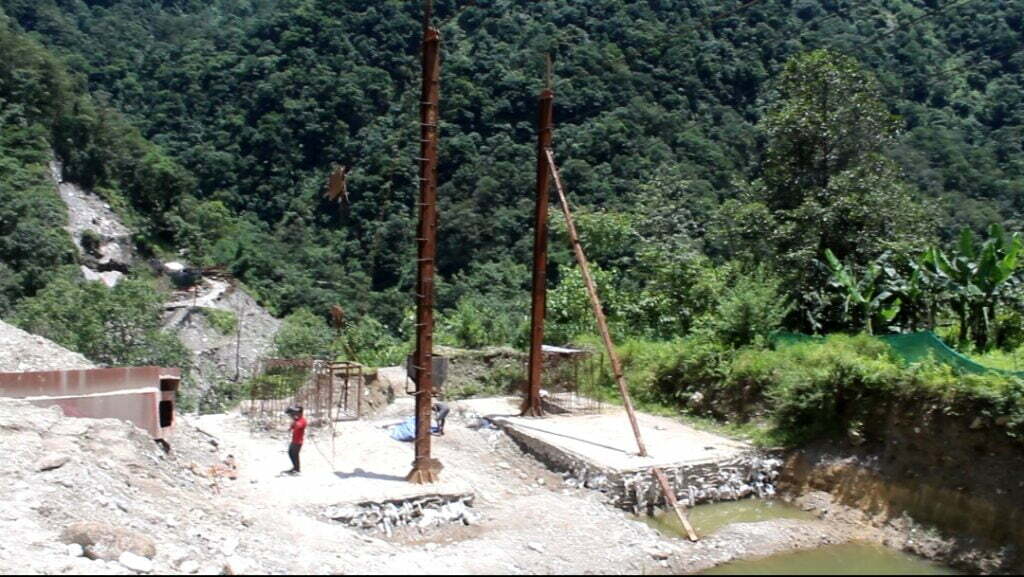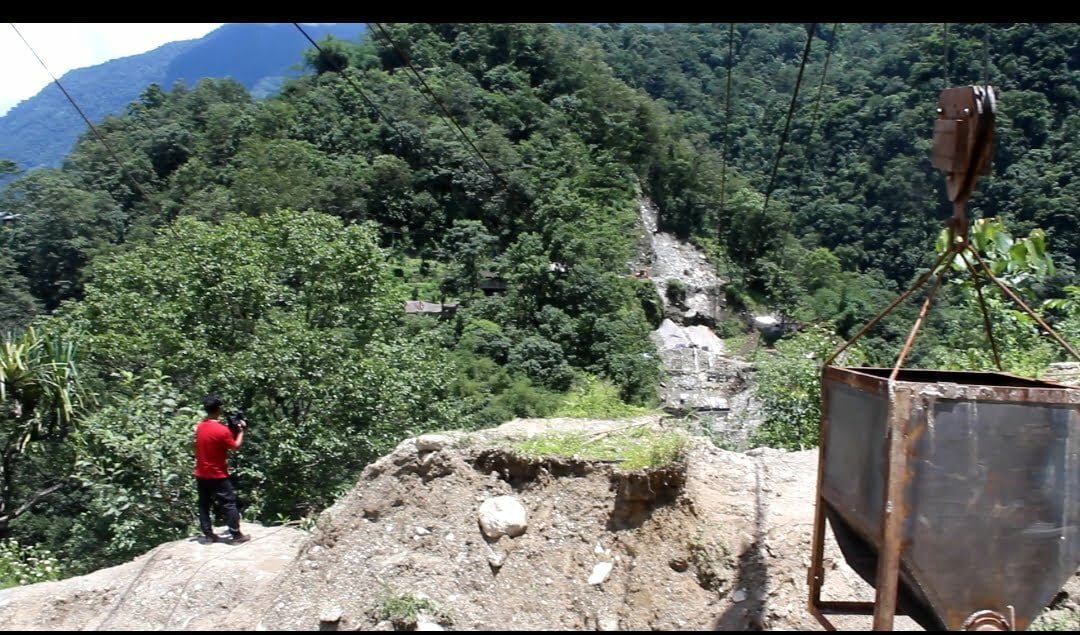Beyong the tempestuous Mantam stretch of Kanaka river, lies the hidden world of Tingvom and Sakyong-Pentong GPUs in Upper Dzongu. Hidden in the sense that these already remote Lepcha villages do not have permanent road connectivity to the mainstream for past six years.
Only when the river subsides for 3-4 months a year, the around 450 families of these Upper Dzongu villages can directly reach to the nearest town of Mangan on a vehicle. For rest of the year, what should be a routine commute becomes an expedition involving trekking, cross a foot bridge (if it is still there), changing vehicles 2-3 times and sometimes, demonstrating horsepower by ‘ukalo theuling’ the poor vehicle caught in the dreaded S-turning below Mantam.
The great disconnect started on August 13, 2016 during a massive landslide that washed away the road and the bridge at Mantam besides choking the river flow which eventually led to formation of a 3km-long Mantam lake. Houses were also submerged. The lake is no more and is gradually returning to its original river form. Sadly, the roads and the bridge have not returned.
In between, everything has been attempted. Engine-powered rafts to ferry the people across the lake, oar driven rafts were deployed as the lake subside, around three footbridges (steel and bamboo) above the river/lake came and went away, a bailey bridge was installed to allow vehicle movement on dry months. Everything, except a permanent motorable bridge.

“It is already mid-2022 and still we can’t see the bridge”
On August 13, 2016, the normal life of Upper Dzongu residents beyond Mantam came to an abrupt halt. Those settled at Mantam were fortunate to escape with their lives considering the scale & ferocity of the landslide. However, they lost their houses which were either submerged or damaged.
Almost 15 families had to leave their homes and shift to other places. The suspension bridge connecting the two GPUs with rest of Sikkim was also submerged under the water. Mantam Lake went on to become a picnic spot to a ‘beach type’ location for music spots and finally as a person with a dual personality disorder – lake in monsoon and river in dry season.
The bridge project, meanwhile, has been inordinately delayed due to various reasons including technical issues and Covid pandemic.
In 2019, the State government sanctioned approximately Rs 88 crore for construction of a new bridge to National Projects Construction Corporation Limited. The construction work later was subleted to a Siliguri-based construction agency Mohendra Tubes Limited. The time period of the construction of the bridge was 2021, however due to engineering failure, the work tenure has been stretched till November this year.
Speaking with Sikkim Chronicle on June 4, Anjan Gogai, Site engineer NPCC ltd maintained that, “Due to poor road connectivity the construction of the work cannot be completed by November this year”.
The bridge is coming up between Kavem and 5th Mile, Tingvom which would bypass the entire disrupted spot of Mantam.
“Last two years has been challenging for us. Due to Covid restrictions we couldn’t bring labourers to Sikkim and due to bad road connectivity especially during monsoon truck drivers hesitate to drop the supply. This time we are trying and will give all to complete the bridge soon as possible”, Gogai said.
Upper Dzongu villagers and area MLA Pinsto Namgyal Lepcha blamed the contractors for the slow progress in the bridge construction project. They have urged the Roads & Bridges department to intervene and monitor for early completion of the bridge.
Pemtok Lepcha, a panchayat of Sakyong-Pentong GPU said, “It’s been 6 years that the landslide washed away the bridge after which we have been facing problems be it transportation or medical related problems. We have to buy rice (LS chammal) at cost of Rs. 5,000 per sack and when we have medical problems, we have to carry people in our backs and cross the river through 255m long suspension bridge and its sad that some have lost their lives on their way and solution to all our problems is the motorable bridge”.
“In 2019 construction of bridge started and the contractors assured us that they would complete the work by 2020 March. We waited and waited. Again the contactor and the department assured us that by March 2021 the bridge would be ready. However it is already mid-2022 and still now we cannot see the bridge.”
Pemtok Lepcha stressed that last year the bridge structure was built at both sides (Kavem & Tingvom) but later the structure was demolished due to some technical failure. “Due to their mismatch we are suffering. For transporting goods, we have to bring bring it to Kayam, cross the river and take it to our respective homes”
“The last village of the left of Dzongu is Sakyong. For them even to reach district headquarters it will take minimum of 1 week to go and come back”, he said.
Local resident Nimkit Lepcha, also the sitting Zilla of Lingtem-Lingdem, said, “They constantly assure that they will complete in time but in reality, it’s not. We are facing problem, not them. I would like to request the State government to look into this matter on a serious note.”
Likewise, Pintso Namgyal Lepcha, the Dzongu MLA, said, “In every Assembly session, I have been speaking on this particular matter. The problems faced by the residents are genuine and I would like to request officials from the concerned department to take stock of the work that is going out here”

The ACT Angle
The Affected Citizens of Teesta (ACT), an organization established in 2006 has completed 14 years of anti-dam and environment protection movement. The organization’s hotspot is Dzongu where multiple hydel power projects are proposed.
They came forward to protect their land and people on cultural and environmental grounds. They began their protest the National Hydro Power Corporation (NHPC) in 2007. The proposal then was to construct multiple dams on the river Rangyong in Dzongu. The journey began with an indefinite hunger-strike led by the ACT in 2007 and it gained momentum over the years.
ACT introduces themselves as, “an organization of indigenous Sikkimese citizens to protect the land and people from the threat to the Biodiversity Hotspot (Khanchendzonga Biosphere Reserve), endangering the demographic profile to the indigenous primitive Lepcha tribes and the right to live in one’s own homeland with dignity and security due to implementation of numerous mega hydro-electric power projects in one go.”
Speaking with Sikkim Chronicle, ACT general secretary Gyatso Lepcha claimed the tunnelling and using of dynamites while constructing the Namprikthang dam led to the landslide at Mantam.
“I have written ample amount of articles on the Mantam landslide right from the beginning of 2016. We as ACT have been claiming that the Mantam landslide that occurred was due to the dams in the region. If you look it technically, Teesta Urja 1200 Mw of Chungthang dam has power station in Namprikdhang which is underground. During the construction of power stations of Stage III which is near Namprikdhang dynamites was used and that has weaken the nearby mountain and the Syok Bhir was also weakened during that time. The consequences of the construction of dams cannot be seen immediacy and the same happened with Mantam”.
Mantam village comes under the proposed Panam hydel power project and there was some activity upstream at Lingya (about 7 km away from Mantam) where the dam was proposed for 280mw Panam project.
“In early 2008, construction of tunnels in the mountains started and later when they surveyed one of the hills, they found a hot spring which indicates that the land is not feasible and has volcanic activity. After this finding, the construction was stopped, however the damage was done as the existing construction activities like tunnelling went on to become the very reason for the landslide,” Gyatso Lepcha said.
“In Mantam, the Panam project was established itself in a haze and by not getting the needed clearance. As ACT we demanded the scraping of Panam Project. ‘Our fragile Dzongu cannot bear more pain,’ said Gyatso who hails from Passingdong, about 2-3 km ahead of Mantam.
The history of anti-dam protests and struggles in Sikkim dates back to 1994. In 1994, the government of Sikkim proposed the construction of three dams in the then capital, Yuksom. According to the proposal, three dams were to be constructed across the Rakthong Chu: 99 MW project in Ting Ting, 96 MW project in Lethang and 97 MW project in Tashiding. This proposal witnessed strong opposition from the Buddhist lamas from West Sikkim, as Rakthong Chu was considered a holy river and the act of tampering with this natural treasure interfered with their religious sentiments.

